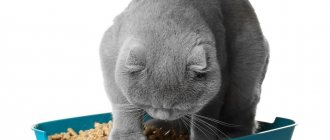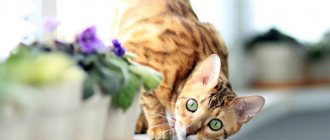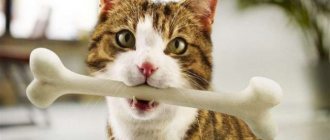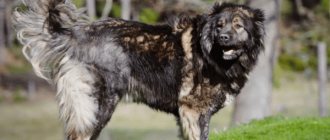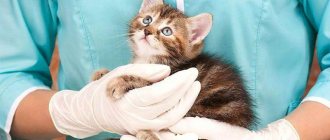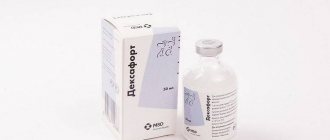With the arrival of summer, the “migration period” traditionally begins in Russia. Some people go on vacation to distant lands, others go to their favorite dacha. Usually they go there with all their children, household members and, of course, pets. Particularly lucky pets are taken out for the entire summer months, the rest are driven weekly through traffic jams to and from the dacha. And along with flea and tick medications, there is a growing demand in pet stores for products to help make those trips easier.
Article on the topic: Meet fully armed. What dangers threaten a pet at the dacha?
Of course, if a dog or cat is afraid to ride in a car, train or other transport, it is worth choosing one of the anti-stress medications that are produced specifically for animals. Let's look at what veterinarians currently offer in such cases.
Bestsellers
According to employees of veterinary pharmacies and pet stores, several anti-stress drugs are in greatest demand. Moreover, the most popular ones are domestically produced.
"Cat Baiyun" ()
Available in two forms: tablets and drops. The latter are the most popular. Contains extracts, decoctions and infusions from plant materials (motherwort, hops, oregano, mint, valerian, peony, etc.). The undoubted advantages of the drug include its natural composition and low price. The inconvenience lies in the need to pour liquid into the mouth 3-4 times a day, as well as the presence of age restrictions: it is indicated only for animals from 10 months. In addition, valerian, which is part of the drug, can cause agitation in cats.
Article on the topic
Animals in the country: how to prepare for a trip with a pet?
"Stop stress" ()
Just like “Cat Bayun”, it is available in tablets and drops, and the liquid form is also more popular. As active ingredients it contains the tranquilizer phenibut and a complex of aqueous extracts of medicinal plants (peony, Baikal skullcap, hops, motherwort, mint and valerian officinalis). The packaging of tablets and drops varies: separately for cats and for dogs. The price of Stop-Stress in pharmacies is low, but if you look closely at the main component, phenibut, not everything is so rosy. The fact is that it can cause drowsiness, nausea, vomiting, and inappropriate behavior. “Stop-stress” is contraindicated for pregnant, lactating animals, young animals under 1 year old, as well as for diabetes mellitus and diseases of the genitourinary system. Take the drug twice a day, and start taking it 3-5 days before the trip.
"Fospasim" ()
Homeopathic medicine. Release form: drops and solution for injection. Consists of natural ingredients. In addition to its calming effect, it improves orienting reactions (can also be used at exhibitions) and promotes rapid adaptation. Does not cause drowsiness or depression of consciousness. Used once a day, the effect is noticeable 30–60 minutes after administration. A definite plus: it can be used for all animals (rodents, ferrets, birds, etc.). There are no age restrictions or contraindications. It costs more than the two above mentioned, but is more convenient to use (once a day).
Vacation without problems. How to keep your pet healthy in the country?
More details
Preparing for the trip
To travel with a pet, you need to stock up on certificates and treat the animal for parasites. Be sure to have a veterinary passport of the cat with you, which indicates: gender, breed, nickname, date of birth, etc. The owner's details are listed in a separate column. The document contains the following information:
- marks for prevention and treatment of worms;
- a list of mandatory vaccinations;
- data on surgical interventions;
- about the implementation of the chip (if any).
The rules change from time to time, so it is recommended to find out about all the points in advance. It is recommended to take wet wipes and disposable diapers with you, as cats often get seasick. To travel by train or plane, you will need to purchase an additional ticket for your pet.
Leave a request for a cat hotel
Second echelon
There are a number of other drugs on the market. They are rarer and, as a result, less popular, although these are all domestic brands.
"Antistress" ()
Question answer
What are the rules for transporting animals in passenger trains?
Available in tablet form separately for cats and dogs. Ingredients: vitamins + motherwort, essentially brewer's yeast with motherwort. It will be useful for animals with a weak nervous system when taken in courses. It does not act quickly, so it is useless to give it immediately before a trip. In this case, it is better to choose another drug as a sedative that will begin to work soon after administration.
"Vetspokoin" ()
Release form: suspension and tablets. The composition includes phenibut, royal jelly and promethazine, which has an antiallergic effect. Phenibut has already been discussed above. According to veterinarians, preparations containing it require caution in use, since animals often experience undesirable reactions to this substance. It is important to avoid overdose! Bee products can also serve as an allergen for animals.
"Fitex" ()
Available in the form of drops. Wonderful natural composition: extracts of valerian officinalis, motherwort, common hop, Baikal skullcap. But you need to give it three times a day. Contraindicated in Greyhounds and animals with low blood pressure. In case of overdose, drowsiness and lethargy may occur.
Dangers of a summer cottage: how to prepare a pet for country life
More details
What is the best way to transport a cat?
Cats have sharp teeth and claws; in a stressful situation, they can even dig into their beloved owner. On the road, it is recommended to purchase a spacious plastic box with a lattice door and side viewing windows. The device is convenient for traveling with your pet in any vehicle, as it is made of durable plastic. The hard bottom allows the cat to stand confidently on its paws and protects it from bumps and falls during traffic. Open carrying areas provide great visibility and airflow. Plastic boxes are light weight and easy to clean. For short distances, you can buy a metal cage, but only for calm cats.
Exotic
Let's look at some more tools that pet owners may come across on the Internet. We are talking about imported “things” that are not registered in Russia, but are offered in online stores on order.
"Bach Drops" (England, although there are other producing countries)
They are a mixture of five different original flower essences of a certain Dr. Bach. Generally intended for humans, but there is a form labeled “pet” that does not contain alcohol, specifically designed for animals. Reviews about this drug are mostly positive, but it is not cheap.
Online stores also offer such products as Anxitane (amino acid), Zylkene (peptide), Calm (chamomile, valerian, hawthorn), soothing gel 'Quiet Moments' (amino acid, vitamins, herbal ingredients).
With a similar composition (amino acids + vitamins + herbs) in various combinations, other variants of sedative drugs may occasionally be found, the names of which make no sense due to their exceptional rarity. As a rule, they are also quite expensive.
Everything's under control. How to deal with pets in the countryside
More details
How cats behave on the road
Every animal has its own character and health characteristics.
Even a cat accustomed to the road can become frightened by something and behave inappropriately. If a pet is transported for the first time, it usually begins to meow heart-rendingly, rush around in the box, and may urinate or drool. Some owners, wanting to help, open the carrier. Advice: don’t do this, the “prisoner” will try to get out of the car, no matter what the cost. A runaway animal will be difficult to find later. It is advisable to put a collar on your pet with the owner’s phone number before the trip. It is necessary to securely secure the carrier in the car so that it does not fall and the cat is not injured in it. Some people take their pet on a car trip wearing only a harness. This way you can transport animals that have been in a car more than once. They breathe calmly, lie in their arms or watch the road through the glass, and react adequately to noises and sounds.
On a note
Attention
In severe, advanced cases, when it is necessary to transport a very nervous animal, a combination of drugs is also possible. For example, start using Feliway at home a week before your trip, and additionally use Fospasim an hour before departure and on the road. The French drugs Feliway and Adaptil () stand apart from traditional sedatives. They are produced in two versions: a spray and a diffuser like a fumigator, which is plugged into an outlet. Both drugs are certified in Russia. Their action is based on imitation of natural calming pheromones for the animal, a synthetic analogue of which is released when the diffuser is turned on or the spray is used. Their advantages (especially the diffuser) include ease of use, inconspicuousness for people, the ability to cover several animals at once if they live in the same room, as well as remote influence: there is no need to give or inject anything to the pet. Disadvantages include the high price, the need for prolonged exposure, and the fact that not all animals are susceptible to their effects. In addition, cats need their own drug (Feliway), dogs need their own (Adaptil), but for other species such drugs simply do not exist. In addition, if the living space is large, then several diffusers may be needed at once. And if an animal leaves the “controlled zone” in which the diffuser operates, then it immediately finds itself outside its field of action.
Elena Kvasova, practicing veterinarian
Where to start getting used to traveling
It is necessary to accustom the animal to being carried while still a kitten so that it calmly reacts to a confined space. If you plan to take an adult cat on a trip, then it is worth treating the box with special pheromones. This way he will get through the road more calmly. If you are traveling by car, you should introduce your furry friend to the car. You can take him in your arms and sit in the salon. Let him sniff everything, climb around the chairs, then you need to start the engine for a short time. The next day you can take a ride around the house. After letting your pet out at home, you should praise him and treat him with goodies. It is advisable to do such training within a week or two before traveling. The purpose of short walks is to let the cat know that it is not in danger.
Should you always give a sedative?
Cats should only be given sedatives if prescribed by a veterinarian. Problems with behavior, for example, neuropsychic disorders in the form of aggression, can be cured not with pills, but with affection and a properly organized educational process. The same applies to frequent moving, tagging, and training animals to visit groomers. It is necessary to understand what caused this or that condition, and try to get rid of it not with chemistry, but with a sensitive attitude and education.
Long-term use of certain drugs can be addictive. And then, over time, to achieve the desired result, the dose will have to be increased or switched to stronger drugs. In some cases, sedatives cause intoxication; there are cases of nervous system disorders as a result of frequent use of these drugs. An animal under the influence of sedatives becomes a sluggish and apathetic creature, but a cat is a friend and beloved family member. Live communication and overcoming difficulties in a pet’s life are part of the joy and warmth that these amazing and sensitive animals give their owners.
It is better to replace chemicals with homemade methods that help calm your pet without harming its health. One of the harmless sedatives is bergamot oil. If you saturate a napkin with it and attach it to your cat's collar, it will most likely calm down.
Sedatives for cats have certain contraindications. But most of them are prohibited for use in cases of low blood pressure, during pregnancy and lactation, under the age of one year, in the presence of pathologies of the genitourinary system and diabetes mellitus, and in case of individual intolerance to the components of the drugs.
Manifestations of anxiety
Nervous behavior
These signs of fear can be misinterpreted by inexperienced owners: when the cat is under severe stress, it tries to calm itself down by grooming or even purring. In this case, licking the fur is hasty; often the animal becomes fixated on one area (paw, side), where baldness occurs due to this (self-induced alopecia).
Appetite changes - from complete indifference to food to bouts of gluttony. Sometimes it becomes perverted - the cat begins to chew inedible objects or indoor plants.
Trying to hide
If a cat is frightened by something specific - loud noises, an unfamiliar place, a person or a dog, the natural reaction of a small predator will be to flee. The animal will look for a secluded and protected place, so they often hide under the bathtub, under the bed, or in the closet.
Aggression
Depending on the cat's temperament and circumstances, a frightened cat can turn into extreme aggressiveness. An affectionate furry pet in a state of passion turns into a crazy creature with claws and fangs, terrifying its owners. Cats fight for their lives much more selflessly than dogs. Another question is that their lives are often not in danger: the bitter anthelmintic is not a deadly poison at all, and the explosions outside the window are just festive fireworks.
In dominant individuals, aggression may be associated not with fear, but with territorial behavior: a cat can rush at a dog or another cat if it is confident in its abilities, and sometimes even at a child if he provokes the animal.
External signs of an aggressive attitude:
- The cat tries to appear as big as possible: arches its back, its fur stands on end (especially on its back along the spine), its tail fluffs out.
- The animal howls threateningly, hisses and snorts, grins.
- The pupils are constricted, the gaze is fixed on the object.
- The tail whips at the sides and twitches.
- The cat hits with its front paw when trying to get closer.
Panic
If the animal is unable to either defend itself or escape, then instead of humility and submission, a panic attack should be expected. The cat can make heartbreaking screams, saliva flows profusely, like foam, involuntary urination occurs, and sometimes defecation occurs.
External signs of fear:
- The cat freezes, presses itself to the floor/table, cowers (pulls its tail and paws under itself).
- The pupils are dilated, the cat hides its eyes and does not look at the person.
- Ears are pressed to the head.
